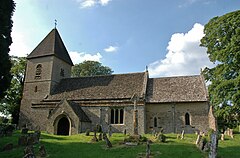Fritwell
| Fritwell | |
|---|---|
 St Olave's parish church |
|
| Fritwell shown within Oxfordshire | |
| Population | 736 (2011 Census) |
| OS grid reference | SP5229 |
| Civil parish |
|
| District | |
| Shire county | |
| Region | |
| Country | England |
| Sovereign state | United Kingdom |
| Post town | Bicester |
| Postcode district | OX27 |
| Dialling code | 01869 |
| Police | Thames Valley |
| Fire | Oxfordshire |
| Ambulance | South Central |
| EU Parliament | South East England |
| UK Parliament | |
| Website | Fritwell Parish Council |
Fritwell is a village and civil parish about 5 1⁄2 miles (9 km) northwest of Bicester in Oxfordshire. The 2011 Census recorded the parish's population as 736.
The parish's southern boundary is a stream that flows eastwards through Fewcott and past the villages of Fringford and Godington before entering Buckinghamshire where it becomes part of Padbury Brook, a tributary of the Great Ouse. The northeastern boundary of Fritwell parish is the main road between Bicester and Banbury. On other sides the parish is bounded by field boundaries.
The Portway, a road that predates the Roman conquest of Britain, runs north–south parallel with the River Cherwell and passes through the western part of the parish.
The village's toponym is derived from Fyrht-wielle or Fyrht-welle, which is Old English for a wishing well.
After the Norman conquest of England in 1066 William FitzOsbern, 1st Earl of Hereford held a manor of 10 hides of land at Fritwell. William's son Roger de Breteuil, 2nd Earl of Hereford inherited his estates when William died in 1071, but in 1075 Roger took part in the Revolt of the Earls, was defeated by William I and imprisoned. The Crown confiscated and redistributed Roger's lands and seems to have given Fritwell to Roger de Chesney. The manor descended in the de Chesney family until 1160 by which time Maud, Daughter of William de Chesney, had become married to Henry II's chamberlain Henry FitzGerold. Henry and Maud's son Warin FitzGerold had inherited the manor by 1198 and died in 1216. The manor then passed to Warin's daughter Margaret, who was married to Baldwin de Redvers, son of William de Redvers, 5th Earl of Devon. The manor remained in the de Redvers family until Isabella de Fortibus, Countess of Devon died in 1293. One of the Countess's heirs was Warin de Lisle, a descendant of Margaret de Chesney. Warin's son Robert was created 1st Baron Lisle of Rougemont. In 1368 Robert de Lisle, 3rd Baron Lisle surrendered all his lands to Edward III. From then onwards the tenants of the de Lisle manor were tenants-in-chief.
...
Wikipedia

